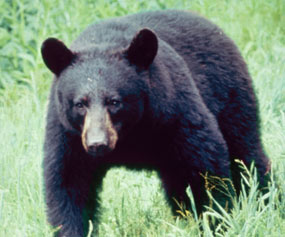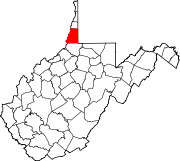
The Hopewell tradition describes the common aspects of an ancient pre-columbian Native American civilization that flourished in settlements along rivers in the northeastern and midwestern Eastern Woodlands from 100 BCE to 500 CE, in the Middle Woodland period. The Hopewell tradition was not a single culture or society, but a widely dispersed set of populations connected by a common network of trade routes. This is known as the Hopewell exchange system.

The Allegheny Mountain Range, informally the Alleghenies and also spelled Alleghany and Allegany, is part of the vast Appalachian Mountain Range of the Eastern United States and Canada and posed a significant barrier to land travel in less developed eras. The barrier range has a northeast–southwest orientation and runs for about 400 miles (640 km) from north-central Pennsylvania, through western Maryland and eastern West Virginia, to southwestern Virginia.

The Monongahela culture were a Native American cultural manifestation of Late Woodland peoples from AD 1050 to 1635 in present-day western Pennsylvania, western Maryland, eastern Ohio, and West Virginia. The culture was named by Mary Butler in 1939 for the Monongahela River, whose valley contains the majority of this culture's sites.

West Virginia is one of two American states formed during the American Civil War (1861–1865), along with Nevada, and is the only state to form by seceding from a Confederate state. It was originally part of the British Virginia Colony (1607–1776) and the western part of the state of Virginia (1776–1863), whose population became sharply divided over the issue of secession from the Union and in the separation from Virginia, formalized by West Virginia's admittance to the Union as a new state in 1863. West Virginia was one of the Civil War Border states.

Indigenous peoples of the Northeastern Woodlands include Native American tribes and First Nation bands residing in or originating from a cultural area encompassing the northeastern and Midwest United States and southeastern Canada. It is part of a broader grouping known as the Eastern Woodlands. The Northeastern Woodlands is divided into three major areas: the Coastal, Saint Lawrence Lowlands, and Great Lakes-Riverine zones.
U.S. Route 13 is a north–south U.S. highway established in 1926 that runs for 517 miles (832 km) from Interstate 95 just north of Fayetteville, North Carolina to U.S. Route 1 in Morrisville, Pennsylvania, a northeastern suburb of Philadelphia. In the U.S. state of Virginia, US 13 runs north–south through the Hampton Roads and Eastern Shore regions of the state, using the Chesapeake Bay Bridge–Tunnel to get between the two. In the Hampton Roads area, it uses Military Highway to bypass the city centers. It is most usually a four-lane highway, sometimes up to freeway or expressway standards with controlled access.
The Prehistory of West Virginia spans ancient times until the arrival of Europeans in the early 17th century. Hunters ventured into West Virginia's mountain valleys and made temporary camp villages since the Archaic period in the Americas. Many ancient human-made earthen mounds from various mound builder cultures survive, especially in the areas of Moundsville, South Charleston, and Romney. The artifacts uncovered in these areas give evidence of a village society with a tribal trade system culture that included limited cold worked copper. As of 2009, over 12,500 archaeological sites have been documented in West Virginia.

Big Ugly Wildlife Management Area is located on 3,061 acres (1,239 ha) near Logan in Lincoln County, West Virginia. The Big Ugly's steep terrain is covered with mixed hardwoods second growth woodlands. Camping is not allowed at Big Ugly WMA, but is available at nearby Chief Logan State Park.

Elklick Woodlands Natural Area Preserve is a 226-acre (91 ha) Natural Area Preserve located in Fairfax County, Virginia. Owned by the Fairfax County Park Authority, it is protected with a local conservation easement, and preserves a globally rare natural community known as a "northern hardpan basic oak-hickory forest". This kind of forest occurs on diabase soil with an underlay of dense plastic clay; such terrain is called "shrink-swell soil" due to extreme variations in moisture availability exhibited throughout the year. Trees which grow in such an environment are stunted, and their relatively open canopies encourage the growth of a wide variety of grasses and herbs in the understory. Such forests were once common around northern Virginia, but many have been lost due to increasing suburbanization of the area.

Grassy Hill Natural Area Preserve is a 1,440-acre (5.8 km2) Natural Area Preserve located in Franklin County, Virginia, just to the west of the town of Rocky Mount. The site is composed of rocky slopes with various hardwood species and patches of Virginia pine. Shallow basic soils, typified by heavy clay, are found among bedrock outcrops rich in magnesium. Rare woodland communities live upon these substrates, and numerous rare plants may be found within grassy forest clearings near the summit. Evidence at the preserve suggests that the majority of the site was once more open, and may have historically been maintained through a natural fire regime that has been suppressed during modern times.

The Clifton F. McClintic Wildlife Management Area, known locally as "the TNT area", is a naturalized area located in Mason County about 5 miles (8 km) north of Point Pleasant, West Virginia. Located on 3,655 acres (1,479 ha) of former wartime industrial land, the WMA is occupied by farmland, woodlands, and wetlands encompassing 31 ponds. The area still contains stored explosives.

Mill Creek Wildlife Management Area is 1,470 acres (590 ha) of steeply forested woodlands located near Milton, West Virginia in Cabell County. Mill Creek WMA can be accessed from Johns Creek Road about three miles north from the Milton exit of I-64.

Morris Creek Wildlife Management Area is located near Clendenin, West Virginia in Clay and Kanawha counties. Located on 9,874 acres (3,996 ha) of steeply forested woodlands, the Morris Creek WMA can be accessed from Morris Creek Road north of Clendenin, or from Leatherwood Creek Road south of Clendenin.

Plum Orchard Lake Wildlife Management Area, is located near Pax, West Virginia in Fayette county. Located on 3,201 acres (1,295 ha) land that varies from wetlands to steeply forested woodlands, the Pleasant Creek WMA rises to an elevation of 1,600 feet (490 m).

Ritchie Mines Wildlife Management Area, is located near Smithville, West Virginia in Ritchie County. Ritchie Mines WMA is located on 2,300 acres (930 ha) of rugged, hilly woodlands.

Sand Hill Wildlife Management Area is located near Parkersburg, West Virginia in Wood and Ritchie counties. Sand Hill WMA is located on 1,987 acres (804 ha) of rugged, hilly oak-hickory woodlands interspersed with timber, oil and gas development sites.

Shannondale Springs Wildlife Management Area is located near Charles Town, West Virginia in Jefferson County. Shannondale Springs WMA is located on 1,361 acres (551 ha) of hills covered with oak-hickory woodlands, brushy areas, and open fields.

Woodland Park is an unincorporated community in Wood County, West Virginia.

Woodland Heights is an unincorporated community in Wood County, West Virginia.


















